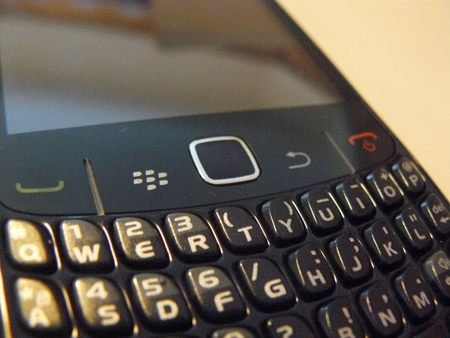
I think we can all agree that today’s BlackBerry Q20 announcement was a bit of a shocker. After putting so much time, effort, and money into bringing BlackBerry up-to-speed with the rest of the smartphone industry, bringing back the ‘tool belt’ of function keys has struck some folks as a step backwards. But after giving it a bit of thought, I think this move might just work in BlackBerry’s favour. Allow me to explain.
One of BlackBerry 10’s biggest problems was arguably its inability to entice users of past devices to upgrade to a new BlackBerry. With a user base of around 79 million when the OS first launched, if even just a quarter of users had migrated, BlackBerry would have sold almost 20 million BlackBerry 10 devices. Instead, BlackBerry has sold roughly 7 million BB10 devices as of fiscal Q3 2014, while legacy devices continue to outsell the new OS. Past reports have also shown that a substantial number of BlackBerry 10 sales were made to people coming from Android or iOS. Although BlackBerry hasn’t reported subscriber base since Q1 2014 when it was sitting at 72 million, it’s safe to assume that we still have around 60 million legacy BlackBerry users out there, give or take a few million. Taking into account BlackBerry 10, that’d mean a reduction of 5 million users since Q1 2014. Considering that 6 million subscribers were lost between Q1 2013 and Q1 2014, that seems pretty reasonable.
So, what am I getting at with all these figures? There are still 60 million users that BlackBerry could, and should, try to migrate to the new platform. Though there may be many of them who won’t consider a BlackBerry again for various reasons, there’s definitely a user base in there somewhere that values what they get out of their legacy device. It’d also be best for BlackBerry if all of those OS7 sales, which continue to exceed BB10 sales, could instead buy into the new platform. This, of course, brings us back to the tool belt. What better way to migrate these users than by giving them a new and improved version of something they’re already comfortable with? It’s the same formula we see from the likes of the iPhone and the Samsung Galaxy series. Though Apple and Samsung may draw criticism for producing similar devices over and over, the sales figures show that this isn’t a recipe they’re in a hurry to abandon – users like migrating to something familiar. And its current form, BlackBerry 10 can be quite daunting to legacy users.
However, it’s also important to look at what direction the company is trying to head. Alongside the Q20 announcement today, we saw the introduction of BlackBerry Enterprise Service 12, the eBBM Suite for enterprise customers, and the announcement of two major companies migrating to BES10. There’s a very serious focus on enterprise, and rightly so – 20% of BlackBerry’s subscriber base is made up of enterprise clients. Trouble is, with over 80,000 BES installations around the world, only 28,000 of these are BES10. There’s no telling how many of those even use BlackBerry 10 devices, seeing as BES10 can manage iOS and Android devices. With BIS gone on BlackBerry 10, enterprise is going to be a key source of service revenue for BlackBerry in the future, making it crucial to migrate those 52,000 BES5 installations over to BES10, and preferably with BlackBerry 10 devices.
This, once again, brings us to familiarity. Enterprise, perhaps even more so than regular consumers, does not like big changes. This is an environment in which people don’t want to waste time adapting to a new platform – they want to be able to pick up their new device and get back to business. Bringing back the tool belt ensures that all of those enterprise users rocking legacy BlackBerry’s will have something familiar to migrate to next time their company upgrades their phones, even if the company goes BYOD.
It’s also worth mentioning that, regardless of who buys it, the tool belt still has its advantages. The trackpad allows for much more accurate text selection than a touch screen, especially on the smaller display of a device with a physical keyboard. Moreover, the physical Dial and End keys allow you to easily answer and end calls without even glancing at the phone. Since this’ll be the first time the tool belt appears on BlackBerry 10, it also opens the door for BlackBerry to try some new things. A few folks in the community have already wondered if it might be possible to implement a fingerprint scanner into the trackpad, a technology for which BlackBerry was granted a patent back in 2009. BlackBerry 10 was never intended for the Menu or Back button either, and it’ll be interesting to see how BlackBerry makes use of those two — this could be key in making the transition from legacy to BB10 easy.
Ultimately though, I don’t think this move is likely to have any negative repercussions for BlackBerry. Even though the addition of physical keys will take up space on the device, BlackBerry is promising a 3.5-inch screen. That makes it the biggest screen ever on a physical keyboard BlackBerry, and the same size as the screen on the iPhone 4S. There might be the odd joke made about BlackBerry being old school, but considering that BlackBerry is no longer chasing the average consumer, that seems hardly relevant. What is relevant is attacking markets where BlackBerry is still a name with status. By making the transition from old devices easier, BlackBerry might just have a shot at retaining that status.
What do you all think of BlackBerry bringing back this feature? Are you for or against it?